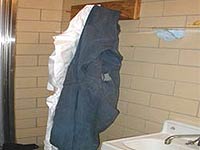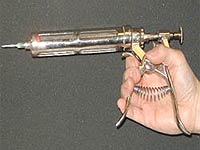Direct routes
Direct routes of PRRSV transmission within and between pig populations include infected pigs and contaminated semen. The PRRSV has been recovered from a variety of porcine secretions and excretions including blood, semen, saliva, feces, aerosols and milk and colostrum. Vertical transmission during mid to late gestation has also been reported. Horizontal transmission has been reported following direct contact between infected animals and naïve animals, as well as transmission via semen of infected boars. Specifically, infectious PRRSV and PRRSV RNA have been detected in the semen of experimentally infected boars up to 43 and 92 days, respectively post-infection. Fecal shedding remains a highly debated issue; several studies report the presence of PRRSV in feces from 28 to 35 days following experimental infection whereas others report no detection of virus in fecal samples.
Persistent infection is a characteristic of PRRSV infections in pigs and plays a major role in the control and eradication of the disease. PRRSV persistence is a “smoldering” infection, and virus is present at low levels within the animal, eventually decreasing with time. The mechanism in which the virus uses to evade the immune system remains unknown at this time. The duration of PRRSV persistence has been documented in a number of studies, but results are highly variable. Using polymerase chain reaction, (PCR) testing, PRRSV RNA has been detected in breeding gilts (6-7 months of age) out to 120 days post-infection with shedding to naïve sentinels reported up to 86 days. In regards to PRRSV persistence at the population level over time, PRRSV was detectable in 100% of 60 experimentally inoculated pigs 3 weeks of age up to 63 days post-infection and in 90% of the same pigs on day 105 post-infection. The in utero infection of fetuses at 85-90 days of gestation resulted in congenitally infected offspring with detectable PRRSV RNA in sera at 210 days post-farrowing. Sentinel pigs co-mingled with these infected pigs (98 days post-farrowing) developed anti-PRRSV antibodies 14 days later. Finally, prolonged persistence of PRRSV in individual animals, ranging from 154-157 days post-infection has been reported.
Indirect routes
Fomites
Several routes of indirect transmission by fomites have been identified in recent years. Specifically, boots and coveralls have been identified as potential sources of PRRSV to naïve pigs (figure 1). The risk of transmission via these routes can be reduced through the use of protocols such as changing boots, coveralls, washing hands, showering and incorporating 12 hours of down time between pig contact periods. Due the propensity for PRRSV replication and circulation in the bloodstream, needles have also been recognized as an indirect means of PRRSV transmission between pigs (figure 1). Finally, mechanical transmission of PRRSV through a series of coordinated sequence of events involving fomites (boots, coolers and containers, shipping parcels, vehicles) and behavior patterns of farm personnel has also been demonstrated in cold and warm weather. However, studies have demonstrated that certain intervention strategies, such as the use of disposable footwear, boot baths, the wearing of gloves and double-bagging products designated for entry into farms significantly reduced the level of PRRSV contamination on the surface of objects and mechanical spread of the virus.

 |
 |
| Fig. 1. PRRSV can be mechanically transmitted within a farm though contaminated needles, coveralls and boots. | |
Transport vehicles
Transport vehicles have recently been investigated as a potential route of mechanical PRRSV transmission. Using a 1:150 scale model, it was demonstrated that naïve pigs were able to become infected with PRRSV through contact with the interior of a transport model contaminated with PRRSV and that drying of the transport vehicle reduced infection in pigs. Similar results were also achieved using full-size transport vehicles. Recently, a means to enhance drying time through the application of high velocity warm air (TADD system, thermo-assisted drying and decontamination system) was demonstrated to be an effective method of eliminating PRRSV from the interior of contaminated transport. In combination with drying, disinfectants are also widely used to sanitize transport vehicles post-usage; however, differences in disinfectant efficacy following application to PRRSV-contaminated transport vehicles has been observed. Based on these studies, it appears that peroxygens, and glutaraldehyde-quaternary ammonium chloride combinations are highly effective products. These disinfectants need to be applied at the proper concentration using foamers and allowed to remain in contact with cleaned surfaces for the proper period of time (2 hours).



